11 Best Dumbbell Bench Press Alternatives For Chest Day
Dumbbell Bench Press is one of the most effective exercises for building upper body strength, specifically for the chest, shoulders and triceps.
However, sometimes you may find yourself needing an alternative for Dumbbell Bench Press.
Maybe you don’t have a bench (or dumbells) or maybe you’re just looking to add some variety to your workouts.
Whatever the reason, if you’re looking for an exercise to substitute for DB Bench Press then you’re in the right place. I’m about to share with you 10 of my favorite Dumbbell Bench alternatives.
Alternatives for Dumbbell Bench Press
I’ve tried to include as much variety in this list as possible. I have exercises that use all different kinds of equipment – dumbbells, barbells and even one that doesn’t require any equipment at all. I’ve also tried to include both beginner-friendly and more advanced movements as well.
Hopefully, regardless of what equipment you have access to or what your level of experience is, at least one of these alternatives for Dumbbell Bench is just what you’re looking for.
Dumbbell Incline Bench Press
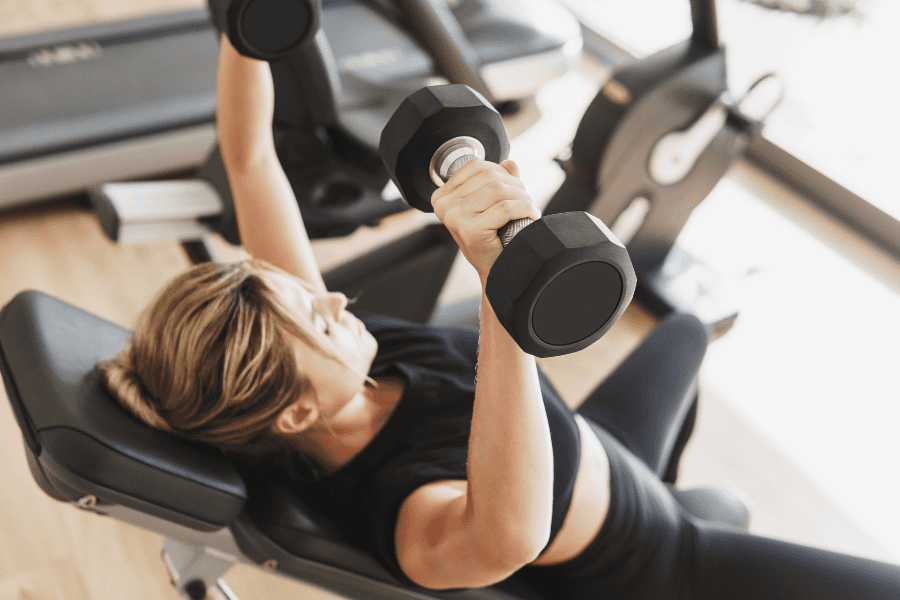
If you’re just looking for a little variety, Dumbbell Incline Bench Press is a great bench press variation that will emphasize the upper chest. If you have an adjustable bench, then you’re only a couple clicks away from switching up your bench press workout.
Step-by-Step Instruction
- Determine the angle for your incline bench. Most programs would refer to a 45-degree angle as ideal for it provides the best chest and shoulder engagement.
- As you go higher with your angle, you are moving more toward a shoulder press. The flatter the bench gets, you are moving more toward a regular bench press.
- Grab your dumbbells, sit on the edge of the bench, and sit the dumbbells on your thighs vertically.
- Take a deep breath, lie flat on your back on the bench, and get your dumbbells in position ready to press.
- Keep your feet flat on the floor.
- Keep your butt on the bench.
- Pull your shoulder blades together and keep the back of your head on the bench. You will slightly arch your back. Keep your core tight and keep the shoulder blades pulled back tight.
- The dumbbells should be slightly angled (representative of the path you are descending with your elbows).
- Press the dumbbells up.
- Control the dumbbells down during the eccentric movement and draw the dumbbells in, keeping the elbows at about a 45-degree angle away from the torso.
- The dumbbells will make contact with your torso right at the nipple line on the chest.
- Once contact is made, drive the dumbbells back up.
Coaching Points
Remember as you move your bench up, the more you are engaging the shoulders and less chest. Be sure your angle matches the goals you’ve set for pressing.
Bench Press
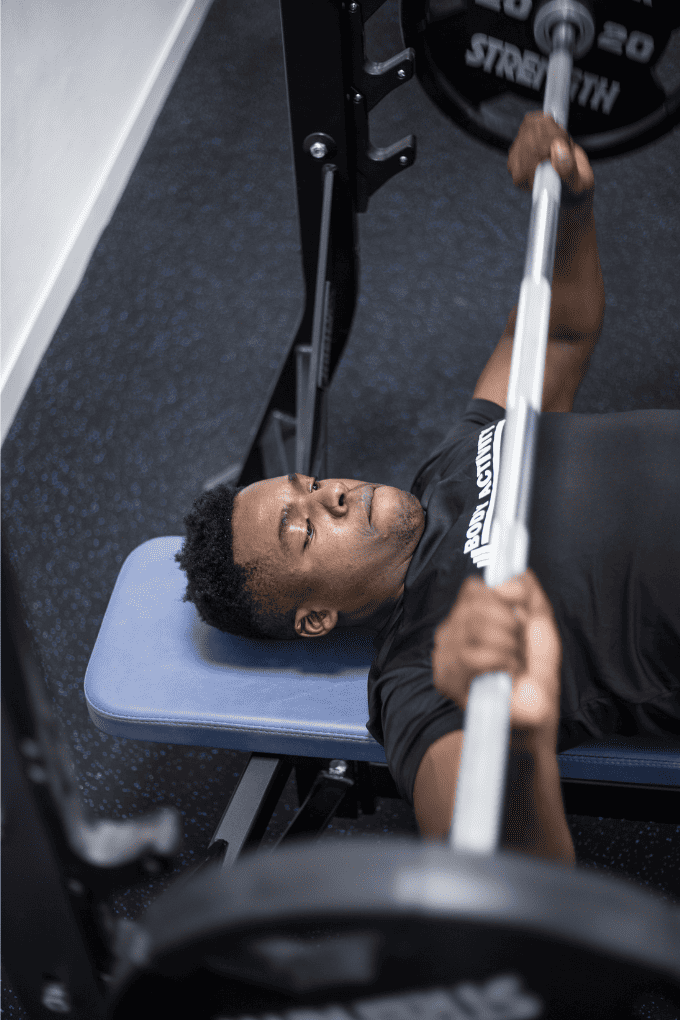
Perhaps the most obvious Dumbbell Bench Press alternative is Barbell Bench Press. Both have their pros and cons, but Barbell Bench Press is one of the best upper-body exercises you can do to build upper-body strength.
Step-by-Step Instructions
- Set the height of the barbell so that when you unrack the barbell, you are only doing a very short upward concentric movement.
- Lie flat on your back on the bench.
- Keep your feet flat on the floor. (Some do find it comfortable to pull the feet back toward their butt as they arch).
- Keep your butt on the bench.
- Pull your shoulder blades together and keep the back of your head on the bench. You will slightly arch your back. Keep your core tight and keep the shoulder blades pulled back tight.
- Take a thumbs-width grip from the knurling and completely close your grip. Keep your knuckles pointing toward the ceiling and squeeze the barbell.
- Later in this article, I will go over other popular grips and why they are used.
- Unrack the weight and take a deep breath.
- Control the barbell down during the eccentric movement and draw the barbell in, keeping the elbows at about a 45-degree angle away from the torso.
- The barbell will make contact with your torso right at the nipple line on the chest.
- Once contact is made, drive the barbell back up to the starting position.
Coaching Points
When doing Bench Press, do not let the elbows flare out away from the midline. The shoulders are incredibly vulnerable in these positions and the sheer force placed on the shoulders will lead to injury if the technique is not made a priority.
Push-Ups

I believe Push-Ups often get overlooked because they’re considered “too simple”. The fact is, the benefits of Push-Ups are very close to Dumbbell Bench.
They’re incredible at developing strength, require no equipment and can be easily modified to make them easier or much more challenging. If you’re leaving Push-Ups out of your training you’re missing out.
Step-by-Step Instruction
- Lie face down on the floor.
- Pull your toes in so that you’re on the tip of your shoes.
- Eyes should be focused straight down or slightly up.
- Pull your hands close to about the nipple line of the chest and bring them out about 2-3 inches away.
- Take a deep breath, engage the core and brace.
- Push yourself up in one unit. There should be no sagging of the waist. The entire body from head to toe should move up and then back down in unison.
- Feel your scapula upwardly rotate and make sure the antagonist muscles (Back and biceps) are fully engaging.
- Lock out your push-up and pause.
- Slowly lower yourself back down and get ready for the next repetition from just above the ground. Do not fully relax at the bottom of the push-up unless your program specifies it.
Coaching Points
Keep the elbows at a 45-degree angle when doing Push-ups. For maximal chest, shoulder, and rotator cuff engagement, do not let the elbows flare out away from the middle. Also, do not let the elbow hug right next to the torso.
Alternating Dumbbell Bench Press
I love the variation that Alternating Dumbbell Bench Press provides. By holding one dumbbell in the air while the other one presses you get additional benefits like – additional time under tension, shoulder stability and anti-rotational core stability.
It’s one of my favorite Dumbbell Bench Press variations.
Step-by-Step Instructions
- Sit on the edge of the bench with dumbbells resting on each thigh.
- Lay back on the bench and press both dumbbells to full extension.
- Now, lower the right dumbbell down to just outside the chest, keeping the elbow at roughly a 45-degree angle to the body.
- Press that dumbbell back up to full extension.
- Next, lower the opposite dumbbell down, same as the first, and press back to extension.
Coaching Points
Hold and stabilize the non-repping arm at full extension and only rep one dumbbell at a time. As the arms begin to fatigue, you may find one (or both) arms start to drift down as you’re repping the opposite arm. Try to keep that opposite dumbbell pressed at full extension!
Don’t turn the movement into a ‘piston-pumping’ type action. I’ll see athletes that will have one dumbbell going up at the same time the other is going down. Keep one dumbbell at extension until the opposite rep is completed.
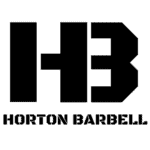
Tired of coming up with your own workouts? But don’t want to pay an arm and a leg?
I post workouts 5 days a week right here. (Did I mention they’re free?)
Incline Barbell Bench
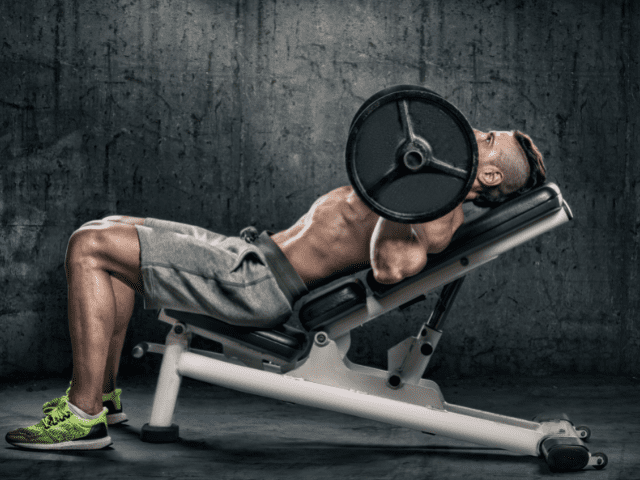
Incline Bench Press is another solid Bench Press alternative that can add variety and target the upper chest.
Step-by-Step Instructions
- Determine the angle for your incline bench. Most programs would refer to a 45-degree angle as ideal for it provides the best chest and shoulder engagement.
- As you go higher with your angle, you are moving more toward a shoulder press. The flatter the bench gets, you are moving more toward a regular bench press.
- Set the height of the barbell so that when you unrack the barbell, you are only doing a very short upward concentric movement.
- Lie flat on your back on the bench.
- Keep your feet flat on the floor.
- Pull your shoulder blades together and keep the back of your head on the bench. You will slightly arch your back. Keep your core tight and keep the shoulder blades pulled back tight.
- Take a thumbs-width grip from the knurling and completely close your grip. Keep your knuckles pointing toward the ceiling and squeeze the barbell.
- Unrack the weight and take a deep breath.
- Control the barbell down during the eccentric movement and draw the barbell in, keeping the elbows at about a 45-degree angle away from the torso.
- The barbell will make contact with your torso right at the nipple line on the chest.
- Once contact is made, drive the barbell back up to the starting position.
Coaching Points
Do not let the elbows flare out away from the midline. The shoulders are incredibly vulnerable in these positions and the sheer force placed on the shoulders will lead to injury if the technique is not made a priority.
Floor Press
Don’t have a bench? Floor Press is a great Bench Press alternative that can be done, you guessed it, on the floor.
Step-by-Step Instructions
- Set your barbell up in the rack at the proper height to be able to rack and unrack the bar safely*.
- Lay on your back with knees bent, feet flat on the floor.
- Engage your lats and set yourself up basically the same as you would for Bench Press.
- Grab the bar using a close grip**, hands right about on the edge of the knurling.
- Unrack the bar, lower it down until the triceps lightly tap the floor and then press it back to extension.
Coaching Points
*Always test your barbell height with an empty bar. I’ve been doing Floor Presses for twenty years now and can still struggle with nailing the best height on my first try.
**Floor Press is generally done using a close grip to emphasize the demand on the triceps, however you can go with a wider grip if you choose to.
Landmine Press
If you have a landmine, Landmine Presses are an excellent exercise both as an alternate pressing movement and a unique exercise to add some variety.
How To
- Setup a landmine attachment with a barbell.
- Grab the end of the barbell and start with it at chest level.
- Feet should be shoulder-width apart with knees slightly bent and core braced.
- Remove one hand from the bar and then press the bar to full extension with the other arm.
- Lower the bar back to chest level under control.
Coaching Points
Keep the core braced and maintain a neutral torso. If you find yourself leaning back and arching the low back, lower the weight if needed and correct your form.
If you don’t have a landmine attachment, don’t worry! Here is how you can make your own DIY Landmine Attachment with just a tennis ball.
Dips

One of my all-time favorite exercises for developing pressing strength is Dips.
Step By Step Instructions
- Attach your dip rack to your rack. This process will vary based on your rack and dip attachment. Follow the manufacturer’s instructions closely.
- Set your dip rack just above waist height. This will allow enough room for your feet not to hit the ground while doing reps, but not so high you feel you have to jump up into your first rep.
- Starting position is hands on bars, arms extended, knees slightly bent and feet crossed (crossing feet is optional but does help with unwanted swinging in my experience.
- Descend down by bending the elbows and slightly leaning forward.
- Lower yourself under control until the triceps become parallel with the ground and then drive yourself back up to the starting position.
Coaching Points
The biggest mistake I see with dips is a poor range of motion. If someone is struggling to be able to do reps, the easiest solution is to simply not lower yourself into a full rep, but this is incorrect. If a lifter cannot perform a full rep they should switch to one of the variations listed below.
Medicine Ball Chest Pass
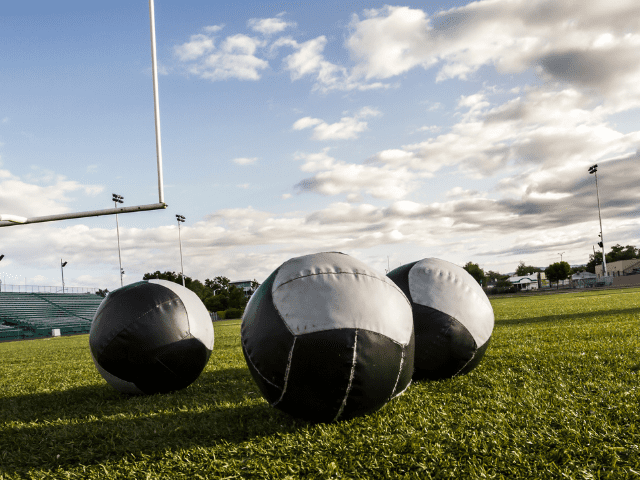
Medicine Ball Chest Pass is basically an explosive version of the Dumbbell Bench Press.
How To
- Grab a medicine ball and a partner (or a solid wall)
- Start on your knees, sit back onto your calves and hold the ball at your chest.
- Explosively drive forward with the hips and throw the ball forward to your partner.
- The forward hip extension should cause you to fall forward.
- Catch yourself with your hands and then explosively push yourself back up to your starting position.
Coaching Points
Med Ball Chest Passes can be done from the knees as described above, but can also be done from a standing position. Regardless of what starting position you use, brace the core and be explosive!
Dumbbell Incline Flys

Dumbbell Incline Flys won’t build strength nearly as well as Dumbbell Bench, but they can be perfect to add some variety to your workout.
Step-by-Step Instruction
- Determine the angle for your incline bench. Most programs would refer to a 45-degree angle as ideal for it provides the best chest and shoulder engagement.
- Grab your dumbbells, sit on the edge of the bench, and sit the dumbbells on your thighs vertically.
- Take a deep breath, lie flat on your back on the bench, and get your dumbbells in position ready to press.
- Keep your feet flat on the floor and your butt on the bench.
- Pull your shoulder blades together and keep the back of your head on the bench. You will slightly arch your back. Keep your core tight and keep the shoulder blades pulled back tight.
- Press the dumbbells up.
- Now, keep a slight bend in the elbow and lower the dumbbells down until they’re at shoulder height.
- Finally, flex the chest and pull the dumbbells together, back to arm’s length over the chest.
Coaching Points
Remember as you move your bench up, the more you are engaging the shoulders and less chest. Be sure your angle matches the goals you’ve set for pressing.
Flys should not be done with heavy weights. Stay relatively light, keep the movement very controlled and focus on the stretch.
Cable Crossover Flys

If you have access to a cable crossover machine (hotel gym maybe?), then Cable Crossover Flys can be a great alternative.
How To
- Place single-handle attachments on both sides of a cable crossover machine.
- Stand with feet shoulder-width apart and a slight forward lean through the torso.
- Hold handles with your arms spread and a slight bend in the elbow.
- Press the cables forward until your hands touch. (crossing the arms in the front will add more emphasis to the upper pectorals)
- Slowly bring the hands back to the starting position and repeat.
Coaching Points
Make sure both pins on each side of your machine are on the same notch.

Get Shredded… For Free
Get a free workout Monday through Friday, posted right here on Horton Barbell. These workouts are designed to help you get strong, in shape and look great at the beach!
Final Thoughts
Dumbbell Bench Press is an excellent exercise for developing a strong chest and triceps, but sometimes Dumbbell Bench just isn’t an option. You may not have the proper equipment available to you or at other times you might just be looking to add some variety to your training program.
In these situations, you’ll need a Dumbbell Bench alternative and I hope that at least one of the alternative exercises I’ve listed here fits what you were looking for.

